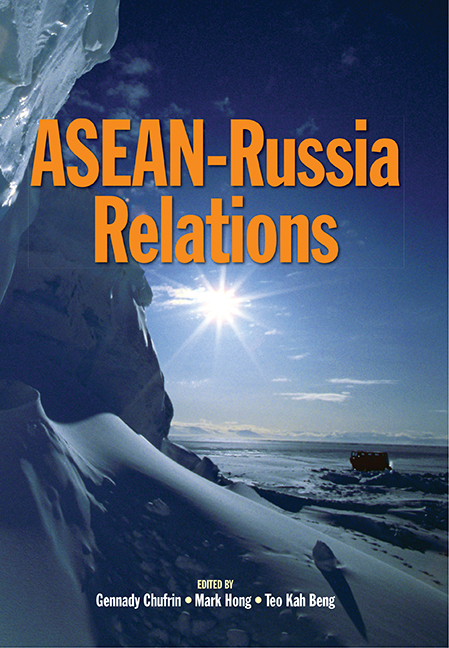Book contents
- Frontmatter
- Contents
- Foreword
- Foreword
- Opening Address
- Opening Address
- The Contributors
- Part I Overview of ASEAN-Russia Relations
- Part II Bilateral Relations
- Part III Security Issues in Southeast Asia
- Part IV Bilateral Economic Relations
- 8 Singapore-Russia Economic Relations
- 9 Russia-Singapore Relations: Thirty-seven Years of Cooperation and Dialogue
- 10 Rationale for a Free Trade Agreement between Russia and Singapore and Russia-ASEAN
- 11 Russia-ASEAN: Problems and Prospects of Economic Cooperation
- Index
10 - Rationale for a Free Trade Agreement between Russia and Singapore and Russia-ASEAN
from Part IV - Bilateral Economic Relations
Published online by Cambridge University Press: 09 November 2017
- Frontmatter
- Contents
- Foreword
- Foreword
- Opening Address
- Opening Address
- The Contributors
- Part I Overview of ASEAN-Russia Relations
- Part II Bilateral Relations
- Part III Security Issues in Southeast Asia
- Part IV Bilateral Economic Relations
- 8 Singapore-Russia Economic Relations
- 9 Russia-Singapore Relations: Thirty-seven Years of Cooperation and Dialogue
- 10 Rationale for a Free Trade Agreement between Russia and Singapore and Russia-ASEAN
- 11 Russia-ASEAN: Problems and Prospects of Economic Cooperation
- Index
Summary
INTRODUCTION
Free Trade Agreements (FTAs) are an instrument of regionalism, defined as “actions by governments to liberalize or facilitate trade on a preferential basis”. It is one of the most elementary forms of regionalism. In recent years, the scope of these FTAs has ranged from being cross-regional or even inter- continental, to individual countries/regional groupings. The recent wave of FTAs emerging in Asia has been more comprehensive, with a wider coverage beyond tariff reductions covering trade in services, investments and regulatory measures to facilitate and promote trade and investment flows.
Essentially, FTAs are meant to reduce business costs and facilitate market access to member countries. An FTA thus provides benefits to its member countries in terms of removal of barriers to trade and investment flows among them, and enhancing the market access for goods exporters as well as for service providers from these countries, as well as expanding investment opportunities abroad. It also serves to strengthen strategic partnership between the member countries.
However, it is important to note that entering into FTAs also requires adjustments to the domestic economy of FTA partners, since it generates greater competition in the domestic economy. Also, FTAs enforce policy discipline, as policy changes are “locked in” through liberalization commitments in these agreements. Further, domestic businesses may also need to adjust their operations to succeed in overseas markets of FTA members that may be highly competitive.
The remainder of this chapter analyses the rationale for a free trade agreement between Singapore and Russia, and also between Russia and ASEAN. The next section briefly discusses the motivations behind Singapore's FTAs and their current status. The final section analyses the rationale for a Singapore-Russia FTA and the possibilities of it being a pathfinder for an ASEAN-Russia FTA, and concludes the chapter.
SINGAPORE'S FTA STRATEGY
Singapore is a small, open economy whose trade policy directions are underpinned by its dependence on the global economy, and the constraints of a small domestic market with limited natural resources.
- Type
- Chapter
- Information
- ASEAN-Russia Relations , pp. 71 - 74Publisher: ISEAS–Yusof Ishak InstitutePrint publication year: 2006



